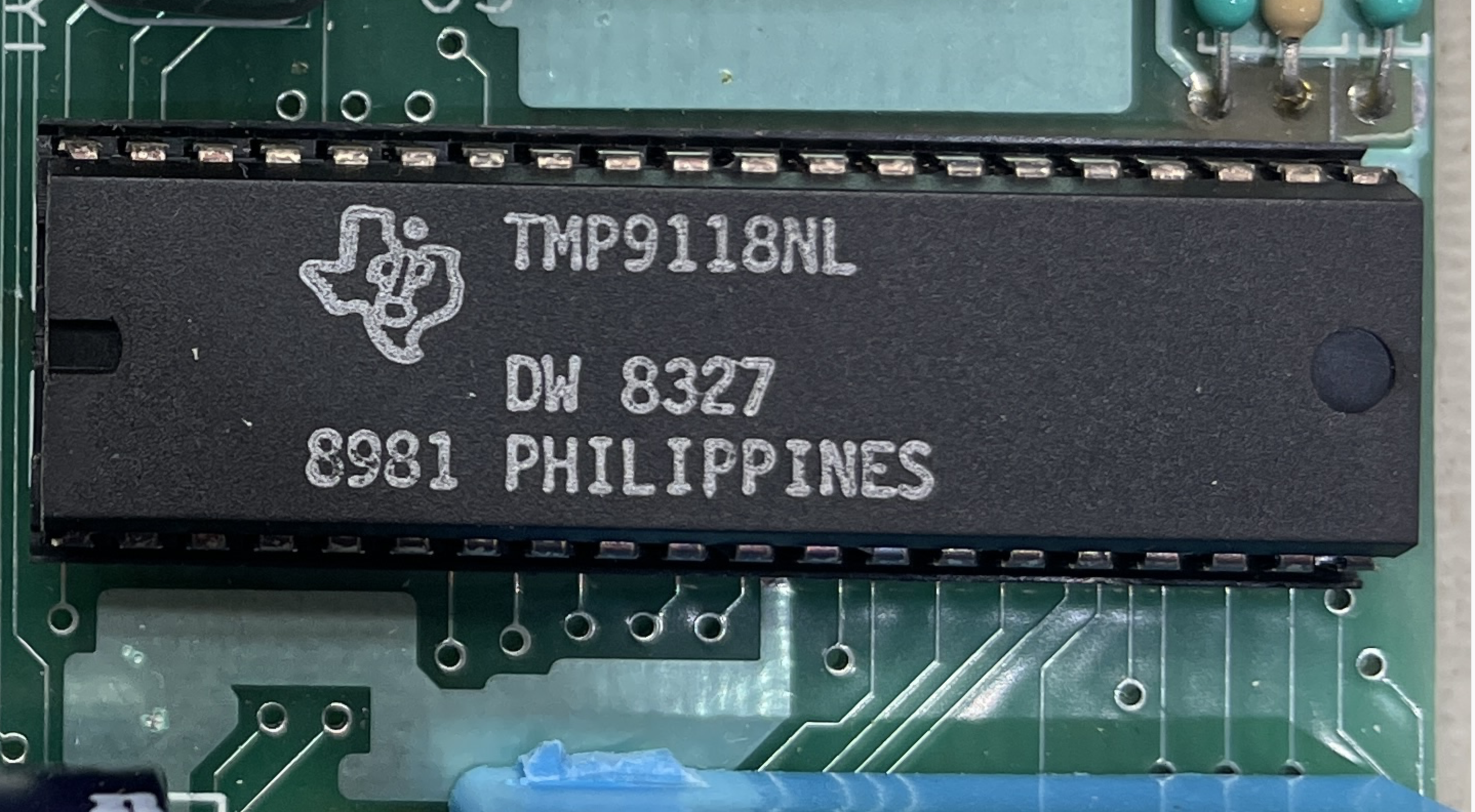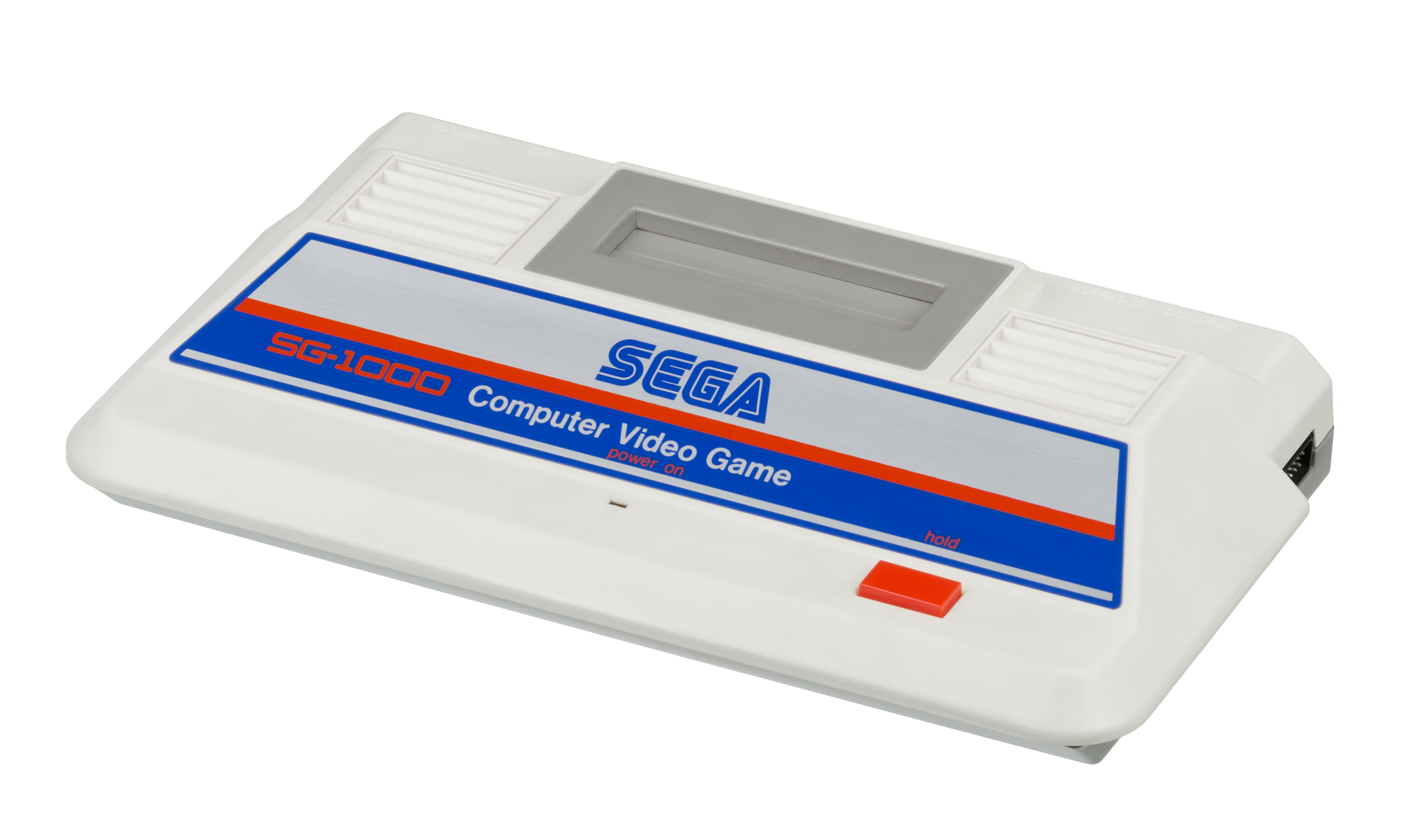|
TMS9918A
VDP TMS9918A VDP TMS9918A The TMS9918 is a video display controller (VDC) manufactured by Texas Instruments, in manuals referenced as "Video Display Processor" (VDP) and introduced in 1979. The TMS9918 and its variants were used in the Casio PV-2000, Coleco Adam, ColecoVision, CreatiVision, Hanimex Pencil II, MSX, Memotech MTX, NABU Personal Computer, PECOS, SG-1000, SC-3000, SV-318, SV-328, Sord M5, TI-99/4, Tatung Einstein, and Tomy Tutor. The TMS9918 generates both grid-based character graphics (used to display text or background images) and sprites used for moving foreground objects. The key features of this chip are, as highlighted in a 1980 presentation by Karl Guttag (one of the designers): *256 by 192 full color pixels per screen *15 different colors and/or shades * Non-interlaced color composite video output *Direct wiring to RAS/CAS type dynamic RAMs *Automatic refresh of dynamic RAMs *General 8-bit memory mapped type CPU interface *CPU accesses RAM via VDP ... [...More Info...] [...Related Items...] OR: [Wikipedia] [Google] [Baidu] |
TI-99/4A
The TI-99/4 and TI-99/4A are home computers released by Texas Instruments (TI) in 1979 and 1981, respectively. Based on TI's own TMS9900 microprocessor originally used in minicomputers, the TI-99/4 was the first 16-bit home computer. The associated TMS9918 video display controller provides color graphics and Sprite (computer graphics), sprite support which were only comparable with those of the Atari 8-bit computers, Atari 400 and 800 released a month later. The TI-99 series also initially competed with the Apple II and TRS-80."Death of a Computer," April 1984, ''Texas Monthly,'' retrieved September 20, 2023 The calculator-style keyboard of the TI-99/4 and the high price were cited as weak points. TI's reliance on ROM cartridges and their practice of limiting develo ... [...More Info...] [...Related Items...] OR: [Wikipedia] [Google] [Baidu] |
SC-3000
The is a home video game console manufactured by Sega. It was Sega's first entry into the home video game hardware business. Developed in response to a downturn in arcades starting in 1982, the SG-1000 was created on the advice of Hayao Nakayama, president of Sega's Japanese arm, and was released on July 15, 1983, the same day that Nintendo released the Family Computer in Japan. It also had a limited release in Australia and New Zealand. The SG-1000 was released in several forms, including the SC-3000 computer and the redesigned SG-1000 II released in 1984. The SG-1000 and the SC-3000 both support a library of 51 ROM cartridge games and 29 Sega My Card games. A third iteration of the console, the Mark III, was released in 1985. It provided an improved custom video display processor over previous iterations and served as the basis for the Master System in 1986, Sega's first internationally released console. All SG-1000 games are fully compatible with the Mark III and the Jap ... [...More Info...] [...Related Items...] OR: [Wikipedia] [Google] [Baidu] |
SG-1000
The is a home video game console manufactured by Sega. It was Sega's first entry into the home video game hardware business. Developed in response to a downturn in arcades starting in 1982, the SG-1000 was created on the advice of Hayao Nakayama, president of Sega's Japanese arm, and was released on July 15, 1983, the same day that Nintendo released the Family Computer in Japan. It also had a limited release in Australia and New Zealand. The SG-1000 was released in several forms, including the SC-3000 computer and the redesigned SG-1000 II released in 1984. The SG-1000 and the SC-3000 both support a library of 51 ROM cartridge games and 29 Sega My Card games. A third iteration of the console, the Mark III, was released in 1985. It provided an improved custom video display processor over previous iterations and served as the basis for the Master System in 1986, Sega's first internationally released console. All SG-1000 games are fully compatible with the Mark III and the J ... [...More Info...] [...Related Items...] OR: [Wikipedia] [Google] [Baidu] |
Sprite (computer Graphics)
In computer graphics, a sprite is a Plane (mathematics), two-dimensional bitmap that is integrated into a larger scene, most often in a 2D video game. Originally, the term ''sprite'' referred to fixed-sized objects composited together, by hardware, with a background. Use of the term has since become more general. Systems with hardware sprites include arcade video games of the 1970s and 1980s; game consoles including as the Atari VCS (1977), ColecoVision (1982), Nintendo Entertainment System, Famicom (1983), Sega Genesis, Genesis/Mega Drive (1988); and home computers such as the TI-99/4 (1979), Atari 8-bit computers (1979), Commodore 64 (1982), MSX (1983), Amiga (1985), and X68000 (1987). Hardware varies in the number of sprites supported, the size and colors of each sprite, and special effects such as scaling or reporting pixel-precise overlap. Hardware composition of sprites occurs as each scan line is prepared for the video output device, such as a cathode-ray tube, without i ... [...More Info...] [...Related Items...] OR: [Wikipedia] [Google] [Baidu] |
PV-2000
The PV-2000, also known as ''RakuGaki,'' is a home computer manufactured by Casio and released in Japan in 1983, with a launch price of ¥29,800. It has similar hardware to MSX machines, but uses a different sound chip, memory allocations and BIOS. History The PV-2000 was released shortly after the PV-1000 game console. It was intended as a home computer and featured an integrated keyboard. It is compatible with PV-1000 controllers but not its games, as it features a different architecture. Technical details The PV-2000 is powered by a NEC PD-780C CPU (compatible with the Zilog Z80) running at 3.579Mhz, with 4 KB RAM, and 16 KB of VRAM. It had a TMS9918A graphics chip capable of generating 256×192 pixels graphics with 16 colours and 32 sprites. Sound was produced by a SN76489AN with three channel sound capability with 4 octaves. The operating system was C83-BASIC v 1.0, similar to MSX BASIC. PV-2000 games Only eleven games were released for the Casio PV-2000, listed here ... [...More Info...] [...Related Items...] OR: [Wikipedia] [Google] [Baidu] |
NABU Network
The NABU Network (Natural Access to Bi-directional Utilities) was an early home computer system which was linked to a precursor of the World Wide Web, operating over cable TV. It operated from 1982 to 1985, primarily in Ottawa, Canada. Its functionality was then revolutionary, though it was not a commercial success. It has been called "The Internet — 10 years ahead of its time" (even though elements of the History of the Internet, history of the internet predate it). Functionality Families, schools, or individuals would purchase a NABU Personal Computer, which would be connected via cable TV to NABU's server (computing), servers. In addition to normal PC capabilities of the time, the computer could download software and information content through the cable feed and could upload primitive information back up to the servers. Applications included games, the programming language Logo programming language, Logo, news/current events, and rudimentary PC banking/shopping. At its ... [...More Info...] [...Related Items...] OR: [Wikipedia] [Google] [Baidu] |
525 Lines
525-line (or EIA 525/60) is an American standard-definition television resolution used since July 1, 1941, mainly in the context of analog TV broadcast systems. It consists of a 525-line raster, with 486 lines carrying the visible image at 30 (29.97 with color) interlaced frames per second. It was eventually adopted by countries using 60 Hz utility frequency as TV broadcasts resumed after World War II. With the introduction of color television in the 1950s,National Television System Committee (1951–1953), Report and Reports of Panel No. 11, 11-A, 12–19, with Some supplementary references cited in the Reports, and the Petition for adoption of transmission standards for color television before the Federal Communications Commission, n.p., 1953], 17 v. illus., diagrs., tables. 28 cm. LC Control No.:5402138Library of Congress Online Catalog/ref> it became associated with the NTSC analog color standard. The system was given their letter designation as CCIR System M in the ... [...More Info...] [...Related Items...] OR: [Wikipedia] [Google] [Baidu] |
Composite Video
Composite video, also known as CVBS (composite video baseband signal or color, video, blanking and sync), is an analog video format that combines image information—such as brightness (luminance), color (chrominance), and synchronization, into a single signal transmitted over one channel. It is most commonly used for standard-definition television, and is sometimes referred to as ''SD video''. The signal is typically carried on a yellow RCA connector, with separate connectors used for left and right audio channels. In professional equipment, a BNC connector is often used instead. Other connector types may appear in compact consumer devices like digital cameras. Composite video supports several line resolutions, including 405-line, 525-line, and 625-line interlaced formats. It exists in three major regional variants based on analog color encoding standards: NTSC, PAL, and SECAM. The same format can also be used to transmit monochrome (black-and-white) video. Signal comp ... [...More Info...] [...Related Items...] OR: [Wikipedia] [Google] [Baidu] |
Bitmap
In computing, a bitmap (also called raster) graphic is an image formed from rows of different colored pixels. A GIF is an example of a graphics image file that uses a bitmap. As a noun, the term "bitmap" is very often used to refer to a particular bitmapping application: the pix-map, which refers to a map of pixels, where each pixel may store more than two colors, thus using more than one bit per pixel. In such a case, the domain in question is the array of pixels which constitute a digital graphic output device (a screen or monitor). In some contexts, the term ''bitmap'' implies one bit per pixel, whereas ''pixmap'' is used for images with multiple bits per pixel. A bitmap is a type of memory organization or image file format used to store digital images. The term ''bitmap'' comes from the computer programming terminology, meaning just a ''map of bits'', a spatially mapped array of bits. Now, along with ''pixmap'', it commonly refers to the similar concept of a spatially mapp ... [...More Info...] [...Related Items...] OR: [Wikipedia] [Google] [Baidu] |
Silicon-gate
In semiconductor electronics fabrication technology, a self-aligned gate is a transistor manufacturing approach whereby the gate electrode of a MOSFET (metal–oxide–semiconductor field-effect transistor) is used as a mask for the doping of the source and drain regions. This technique ensures that the gate is naturally and precisely aligned to the edges of the source and drain. The use of self-aligned gates in MOS transistors is one of the key innovations that led to the large increase in computing power in the 1970s. Self-aligned gates are still used in most modern integrated circuit processes. Introduction IC construction Integrated circuits (ICs, or "chips") are produced in a multi-step process that builds up multiple layers on the surface of a disk of silicon known as a " wafer". Each layer is patterned by coating the wafer in photoresist and then exposing it to ultraviolet light being shone through a stencil-like "mask". Depending on the process, the photoresist that ... [...More Info...] [...Related Items...] OR: [Wikipedia] [Google] [Baidu] |



